Impact Assessment of Tropical Cyclones Amphan and Nisarga in 2020 in the Northern Indian Ocean
Abstract
1. Introduction
2. Materials and Methods
2.1. Historical Cyclones in the Northern Indian Ocean (NIO)
2.2. Estimated Trajectory and Wind of Cyclones Amphan and Nisarga
2.3. Sea Surface Temperature (SST) and Precipitation Product
2.4. Land Use Land Cover (LULC) Product
2.5. Regional Elevation and Potential Storm Surge Area
3. Results
3.1. Frequency of TCs in the NIO and Their Wind Speed
3.2. Assessment of SST during the Cyclone Formation
3.3. Assessment of Cyclonic Precipitation Variability
3.4. Impact of Cyclonic Wind on Land Use Land Cover (LULC)
3.5. Regional Elevation and Cyclonic Storm
4. Discussion
5. Conclusions
Author Contributions
Funding
Institutional Review Board Statement
Informed Consent Statement
Data Availability Statement
Acknowledgments
Conflicts of Interest
References
- Adger, W.N.; Hughes, T.P.; Folke, C.; Carpenter, S.R.; Rockström, J. Social-Ecological Resilience to Coastal Disasters. Science 2005, 309, 1036–1039. [Google Scholar] [CrossRef]
- Burkett, V.; Davidson, M. Coastal Impacts, Adaptation, and Vulnerabilities; Island Press: Washington, DC, USA, 2012; pp. 1–124. [Google Scholar]
- Cochard, R.; Ranamukhaarachchi, S.L.; Shivakoti, G.P.; Shipin, O.V.; Edwards, P.J.; Seeland, K.T. The 2004 Tsunami in Aceh and Southern Thailand: A Review on Coastal Ecosystems, Wave Hazards and Vulnerability. Ecol. Evol. Syst. 2008, 10, 3–40. [Google Scholar] [CrossRef]
- Nicholls, R.J.; Wong, P.P.; Burkett, V.; Codignotto, J.; Hay, J.; McLean, R.; Ragoonaden, S.; Woodroffe, C.D.; Abuodha, P.A.O.; Arblaster, J. Coastal Systems and Low-Lying Areas. In Climate Change 2007: Impacts, Adaptation and Vulnerability. Contribution of Working Group II to the Fourth Assessment Report of the Intergovernmental Panel on Climate Change; Cambridge University Press: Cambridge, UK, 2007; pp. 315–356. [Google Scholar]
- Williams, S.J. Sea-Level Rise Implications for Coastal Regions. J. Coast. Res. 2013, 63, 184–196. [Google Scholar] [CrossRef]
- Mohapatra, M. Cyclone Hazard Proneness of Districts of India. J. Earth Syst. Sci. 2015, 124, 515–526. [Google Scholar] [CrossRef]
- United Nations Development Programme. Reducing Disaster Risk: A Challenge for Development; Bureau for Crisis Prevention and Recovery (BRCP): New York, NY, USA, 2015. [Google Scholar]
- Dube, S.K.; Jain, I.; Rao, A.D.; Murty, T.S. Storm Surge Modelling for the Bay of Bengal and Arabian Sea. Nat. Hazards 2009, 51, 3–27. [Google Scholar] [CrossRef]
- Höffken, J.; Vafeidis, A.T.; MacPherson, L.R.; Dangendorf, S. Effects of the Temporal Variability of Storm Surges on Coastal Flooding. Front. Mar. Sci. 2020, 7, 98. [Google Scholar] [CrossRef]
- Rahmstorf, S. Rising Hazard of Storm-Surge Flooding. Proc. Natl. Acad. Sci. USA 2017, 114, 11806–11808. [Google Scholar] [CrossRef]
- Hoarau, K.; Bernard, J.; Chalonge, L. Intense Tropical Cyclone Activities in the Northern Indian Ocean. Int. J. Climatol. 2012, 32, 1935–1945. [Google Scholar] [CrossRef]
- Reale, O.; Lau, W.K.; Susskind, J.; Brin, E.; Liu, E.; Riishojgaard, L.P.; Fuentes, M.; Rosenberg, R. AIRS Impact on the Analysis and Forecast Track of Tropical Cyclone Nargis in a Global Data Assimilation and Forecasting System. Geophys. Res. Lett. 2009, 36, 1–5. [Google Scholar] [CrossRef]
- Sahoo, B.; Bhaskaran, P.K. Assessment on Historical Cyclone Tracks in the Bay of Bengal, East Coast of India. Int. J. Climatol. 2016, 36, 95–109. [Google Scholar] [CrossRef]
- Mahendra, R.S.; Mohanty, P.C.; Bisoyi, H.; Kumar, T.S.; Nayak, S. Assessment and Management of Coastal Multi-Hazard Vulnerability along the Cuddalore–Villupuram, East Coast of India Using Geospatial Techniques. Ocean. Coast. Manag. 2011, 54, 302–311. [Google Scholar] [CrossRef]
- Parida, B.R.; Behera, S.N.; Oinam, B.; Patel, N.R.; Sahoo, R.N. Investigating the Effects of Episodic Super-Cyclone 1999 and Phailin 2013 on Hydro-Meteorological Parameters and Agriculture: An Application of Remote Sensing. Remote Sens. Appl. Soc. Environ. 2018, 10, 128–137. [Google Scholar] [CrossRef]
- WMO. World Meteorological Organization (WMO) Technical Document, 2015. Tropical Cyclone Operational Plan for the Bay of Bengal and the Arabian Sea; Tropical Cyclone Programme Report No. TCP21, 2015 Edition; Tropical Cyclone Programme; World Meteorological Organization: Geneva, Switzerland, 2015. [Google Scholar]
- Singh, O.P.; Khan, T.A.; Rahman, M.S. Changes in the Frequency of Tropical Cyclones over the North Indian Ocean. Meteorol. Atmos. Phys. 2000, 75, 11–20. [Google Scholar] [CrossRef]
- Alam, E.; Dominey-Howes, D. A new catalogue of tropical cyclones of the northern Bay of Bengal and the distribution and effects of selected landfalling events in Bangladesh. Int. J. Climatol. 2015, 35, 801–835. [Google Scholar] [CrossRef]
- Alam, E.; Momtaz, S.; Bhuiyan, H.U.; Baby, S.N. Climate change impacts on the coastal zones of Bangladesh: Perspectives on tropical cyclones, sea level rise, and social vulnerability. In Bangladesh I: Climate Change Impacts, Mitigation and Adaptation in Developing Countries; Springer: Berlin/Heidelberg, Germany, 2018; pp. 145–166. [Google Scholar]
- Evan, A.T.; Camargo, S.J. A Climatology of Arabian Sea Cyclonic Storms. J. Clim. 2011, 24, 140–158. [Google Scholar] [CrossRef]
- IMD Best Tract Report over the Bay of Bengal (BOB), Arabian Sea (AS) and Land Surface of India. 2020. Available online: https://rsmcnewdelhi.imd.gov.in/report.php?internal_menu=MzM= (accessed on 5 October 2021).
- Krishnan, R.; Sanjay, J.; Gnanaseelan, C.; Mujumdar, M.; Kulkarni, A.; Chakraborty, S. Assessment of Climate Change over the Indian Region: A Report of the Ministry of Earth Sciences (MoES), Government of India; Springer Nature: Dordrecht, The Netherland, 2020. [Google Scholar]
- Basheer Ahammed, K.K.; Pandey, A.C. Coastal Social Vulnerability and Risk Analysis for Cyclone Hazard Along the Andhra Pradesh, East Coast of India. KN-J. Cartogr. Geogr. Inf. 2019, 69, 285–303. [Google Scholar] [CrossRef]
- Lin, I.-I.; Goni, G.J.; Knaff, J.A.; Forbes, C.; Ali, M.M. Ocean heat content for tropical cyclone intensity forecasting and its impact on storm surge. Nat. Hazards 2013, 66, 1481–1500. [Google Scholar] [CrossRef]
- Rao, A.D.; Jain, I.; Murthy, M.R.; Murty, T.S.; Dube, S.K. Impact of Cyclonic Wind Field on Interaction of Surge–Wave Computations Using Finite-Element and Finite-Difference Models. Nat. Hazards 2009, 49, 225–239. [Google Scholar] [CrossRef]
- IPCC. IPCC Contribution of Working Groups I, II and III to the Fourth Assessment Report of the Intergovernmental Panel on Climate Change; IPCC Climate Change 2007: Synthesis Report; IPCC: Geneva, Switzerland, 2007; p. 104. [Google Scholar]
- Gray, W.M. Global View of the Origin of Tropical Disturbances and Storms. Mon. Weather Rev. 1968, 96, 669–700. [Google Scholar] [CrossRef]
- Rotunno, R.; Emanuel, K.A. An Air–Sea Interaction Theory for Tropical Cyclones. Part II: Evolutionary Study using a Nonhydrostatic Axisymmetric Numerical Model. J. Atmos. Sci. 1987, 44, 542–561. [Google Scholar] [CrossRef]
- Yuan, J.; Gao, Y.; Feng, D.; Yang, Y. The Zonal Dipole Pattern of Tropical Cyclone Genesis in the Indian Ocean Influenced by the Tropical Indo-Pacific Ocean Sea Surface Temperature Anomalies. J. Clim. 2019, 32, 6533–6549. [Google Scholar] [CrossRef]
- Hansen, J.; Ruedy, R.; Sato, M.; Lo, K. Global Surface Temperature Change. Rev. Geophys. 2010, 48. [Google Scholar] [CrossRef]
- Cerveny, R.S.; Newman, L.E. Climatological Relationships between Tropical Cyclones and Rainfall. Mon. Weather Rev. 2000, 128, 3329–3336. [Google Scholar] [CrossRef]
- Yu, Z.; Wang, Y.; Xu, H.; Davidson, N.; Chen, Y.; Chen, Y.; Yu, H. On the Relationship between Intensity and Rainfall Distribution in Tropical Cyclones Making Landfall over China. J. Appl. Meteorol. Climatol. 2017, 56, 2883–2901. [Google Scholar] [CrossRef]
- Chen, Y.; Ebert, E.E.; Walsh, K.J.; Davidson, N.E. Evaluation of TMPA 3B42 Daily Precipitation Estimates of Tropical Cyclone Rainfall over Australia. J. Geophys. Res. Atmos. 2013, 118, 11–966. [Google Scholar] [CrossRef]
- Jiang, H.; Halverson, J.B.; Simpson, J. On the Differences in Storm Rainfall from Hurricanes Isidore and Lili. Part I: Satellite Observations and Rain Potential. Weather Forecast. 2008, 23, 29–43. [Google Scholar] [CrossRef]
- Yu, Z.; Yu, H.; Chen, P.; Qian, C.; Yue, C. Verification of Tropical Cyclone–Related Satellite Precipitation Estimates in Mainland China. J. Appl. Meteorol. Climatol. 2009, 48, 2227–2241. [Google Scholar] [CrossRef]
- Maneesha, K.; Ratheesh, S.; Bhaskar, T.V.S. Impact of the Upper Ocean Processes on Intensification of Cyclone Amphan. J. Indian Soc. Remote Sens. 2022, 1–10. [Google Scholar] [CrossRef]
- Mishra, M.; Kar, D.; Santos, C.A.G.; da Silva, R.M.; Das, P.P. Assessment of impacts to the sequence of the tropical cyclone Nisarga and monsoon events in shoreline changes and vegetation damage in the coastal zone of Maharashtra, India. Mar. Pollut. Bull. 2022, 174, 113262. [Google Scholar] [CrossRef]
- Zhang, Y.; Du, Y. Extreme IOD induced tropical Indian Ocean warming in 2020. Geosci. Lett. 2021, 8, 37. [Google Scholar] [CrossRef]
- Johny, C.J.; Singh, S.K.; Prasad, V.S. Validation and Impact of SCATSAT-1 Scatterometer Winds. Pure Appl. Geophys. 2019, 176, 2659–2678. [Google Scholar] [CrossRef]
- Li, X.; Bellerby, R.; Craft, C.; Widney, S.E. Coastal Wetland Loss, Consequences, and Challenges for Restoration. Anthr. Coasts 2018, 1, 1–15. [Google Scholar] [CrossRef]
- Dare, R.A.; McBride, J.L. Sea Surface Temperature Response to Tropical Cyclones. Mon. Weather Rev. 2011, 139, 3798–3808. [Google Scholar] [CrossRef]
- Aid India Amphan: First Situation Report from Sunderbans. Association for India’s Development 2020. Available online: https://aidindia.org/amphan-first-situation-report-from-sunderbans/ (accessed on 21 February 2022).
- Basheer Ahammed, K.; Pandey, A.C. Characterization and Impact Assessment of Super Cyclonic Storm AMPHAN in the Indian Subcontinent through Space Borne Observations. Ocean. Coast. Manag. 2021, 205, 105532. [Google Scholar] [CrossRef]
- Emanuel, K.A. Thermodynamic Control of Hurricane Intensity. Nature 1999, 401, 665–669. [Google Scholar] [CrossRef]
- Ali, M.M.; Swain, D.; Kashyap, T.; McCreary, J.P.; Nagamani, P.V. Relationship Between Cyclone Intensities and Sea Surface Temperature in the Tropical Indian Ocean. IEEE Geosci. Remote Sens. Lett. 2013, 10, 841–844. [Google Scholar] [CrossRef]
- D’asaro, E.; Black, P.; Centurioni, L.; Harr, P.; Jayne, S.; Lin, I.-I.; Lee, C.; Morzel, J.; Mrvaljevic, R.; Niiler, P.P. Typhoon-ocean interaction in the western North Pacific: Part 1. Oceanography 2011, 24, 24–31. [Google Scholar] [CrossRef]
- Ali, M.M.; Jagadeesh, P.V.; Jain, S. Effects of Eddies on Bay of Bengal Cyclone Intensity. Eos Trans. Am. Geophys. Union 2007, 88, 93–95. [Google Scholar] [CrossRef]
- Goni, G.J.; Trinanes, J.A. Ocean Thermal Structure Monitoring Could Aid in the Intensity Forecast of Tropical Cyclones. Eos Trans. Am. Geophys. Union 2003, 84, 573–578. [Google Scholar] [CrossRef]
- Cione, J.J.; Uhlhorn, E.W. Sea Surface Temperature Variability in Hurricanes: Implications with Respect to Intensity Change. Mon. Weather Rev. 2003, 131, 1783–1796. [Google Scholar] [CrossRef]
- D’Asaro, E.A.; Sanford, T.B.; Niiler, P.P.; Terrill, E.J. Cold Wake of Hurricane Frances. Geophys. Res. Lett. 2007, 34. [Google Scholar] [CrossRef]
- Osuri, K.K.; Nadimpalli, R.; Mohanty, U.C.; Niyogi, D. Prediction of rapid intensification of tropical cyclone Phailin over the Bay of Bengal using the HWRF modelling system. Q. J. R. Meteorol. Soc. 2017, 143, 678–690. [Google Scholar] [CrossRef]
- Lin, I.I.; Wu, C.; Pun, I.; Ko, D. Upper-Ocean Thermal Structure and the Western North Pacific Category 5 Typhoons. Part I: Ocean Features and the Category 5 Typhoons’ Intensification. Mon. Weather Rev. 2008, 136, 3288–3306. [Google Scholar] [CrossRef]
- Pothapakula, P.K.; Osuri, K.K.; Pattanayak, S.; Mohanty, U.C.; Sil, S.; Nadimpalli, R. Observational perspective of SST changes during life cycle of tropical cyclones over Bay of Bengal. Nat. Hazards 2017, 88, 1769–1787. [Google Scholar] [CrossRef]
- Rappaport, E.N. Loss of Life in the United States Associated with Recent Atlantic Tropical Cyclones. Bull. Am. Meteorol. Soc. 2000, 81, 2065–2074. [Google Scholar] [CrossRef]
- Changnon, S.A.; Huff, F.A.; Vogel, J.L.; Brunkow, D.A.; Staggs, D.W. Rainfall Prediction-Measurement Systems and Rainfall Design Information for Urban Areas; Circular No. 146; Illinois Institute Of Natural Resources: Urbana, IL, USA, 1980. [Google Scholar]
- Powell, M.D. Changes in the Low-Level Kinematic and Thermodynamic Structure of Hurricane Alicia (1983) at Landfall. Mon. Weather Rev. 1987, 115, 75–99. [Google Scholar] [CrossRef]
- Blackwell, K.G. The Evolution of Hurricane Danny (1997) at Landfall: Doppler-Observed Eyewall Replacement, Vortex Contraction/Intensification, and Low-Level Wind Maxima. Mon. Weather Rev. 2000, 128, 4002–4016. [Google Scholar] [CrossRef]
- Parrish, J.R.; Burpee, R.W.; Marks Jr, F.D.; Grebe, R. Rainfall Patterns Observed by Digitized Radar during the Landfall of Hurricane Frederic (1979). Mon. Weather Rev. 1982, 110, 1933–1944. [Google Scholar] [CrossRef]
- Jiang, H.; Halverson, J.B.; Sim, J. Difference of Rainfall Distribution for Tropical Cyclones over Land and Ocean and Rainfall Potential Derived from Satellite Observations and Its Implication on Hurricane Landfall Flooding Prediction. In Proceedings of the 27th Conference on Hurricanes and Tropical Meteorology, Monterey, CA, USA, 24 April 2006. [Google Scholar]
- Mishra, A.K.; Vanganuru, N. Monitoring a tropical super cyclone Amphan over Bay of Bengal and nearby region in May 2020. Remote Sens. Appl. Soc. Environ. 2020, 20, 100408. [Google Scholar] [CrossRef]
- Chatterjee, S.; Roy, S. A Complete Study on the Costliest Super Cyclone Amphan (May 2020) with Its Devastating Impact on West Bengal, India. Remote Sens. Earth Syst. Sci. 2021, 4, 249–263. [Google Scholar] [CrossRef]
- Look, C.; Friedman, E.; Godbout, G. The Resilience of Land Tenure Regimes during Hurricane Irma: How Colonial Legacies Impact Disaster Response and Recovery in Antigua and Barbuda. J. Extrem. Events 2019, 6, 1940004. [Google Scholar] [CrossRef]
- Yang, D.; Yang, A.; Qiu, H.; Zhou, Y.; Herrero, H.; Fu, C.-S.; Yu, Q.; Tang, J. A Citizen-Contributed GIS Approach for Evaluating the Impacts of Land Use on Hurricane-Harvey-Induced Flooding in Houston Area. Land 2019, 8, 25. [Google Scholar] [CrossRef]
- Quesada-Román, A.; Villalobos-Chacón, A. Flash Flood Impacts of Hurricane Otto and Hydrometeorological Risk Mapping in Costa Rica. Geogr. Tidsskr.-Dan. J. Geogr. 2020, 120, 14–155. [Google Scholar] [CrossRef]
- Shahare, S. Efficacy of the Coastal Regulation and Policies Towards Urban Disaster Risk Reduction: A Case Study of Mumbai. PhD Thesis, Tata Institute of Social Sciences, Mumbai, India, 2014. [Google Scholar]
- Singh, S.; Parida, B.R. Satellite-Based Identification of Aquaculture Farming over Coastal Areas around Bhitarkanika, Odisha Using a Neural Network Method. Proceedings 2018, 2, 331. [Google Scholar] [CrossRef]
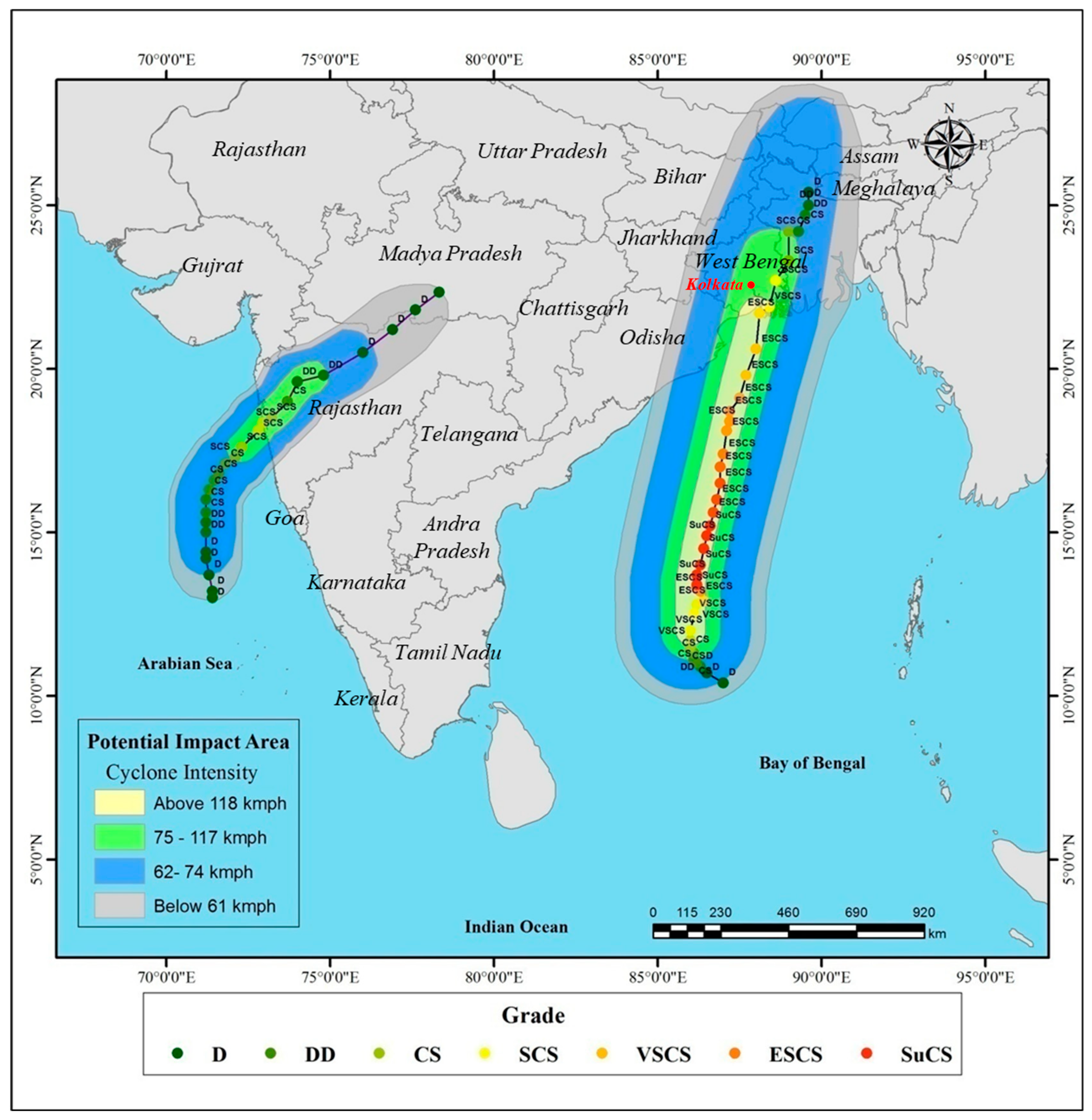


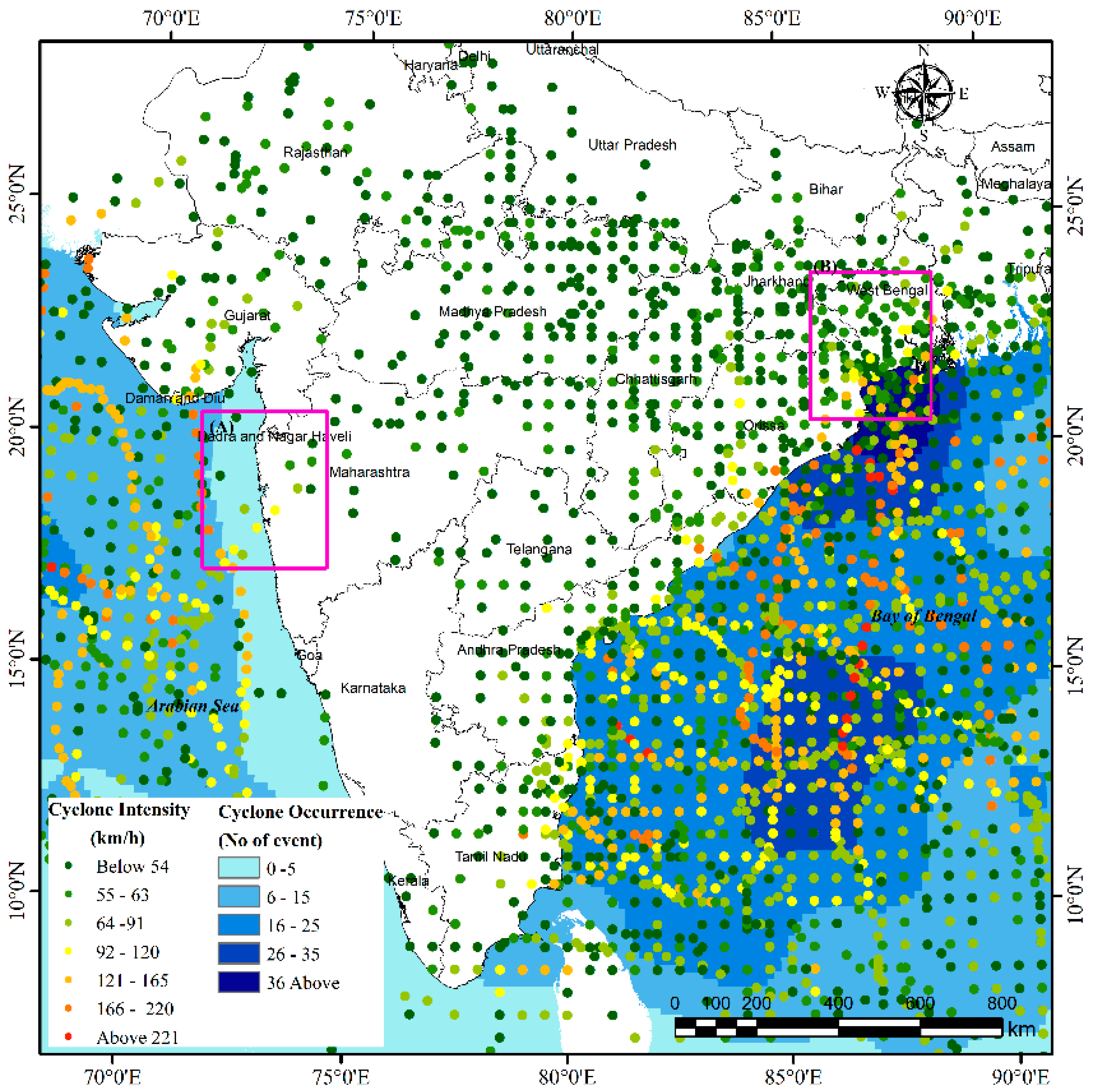
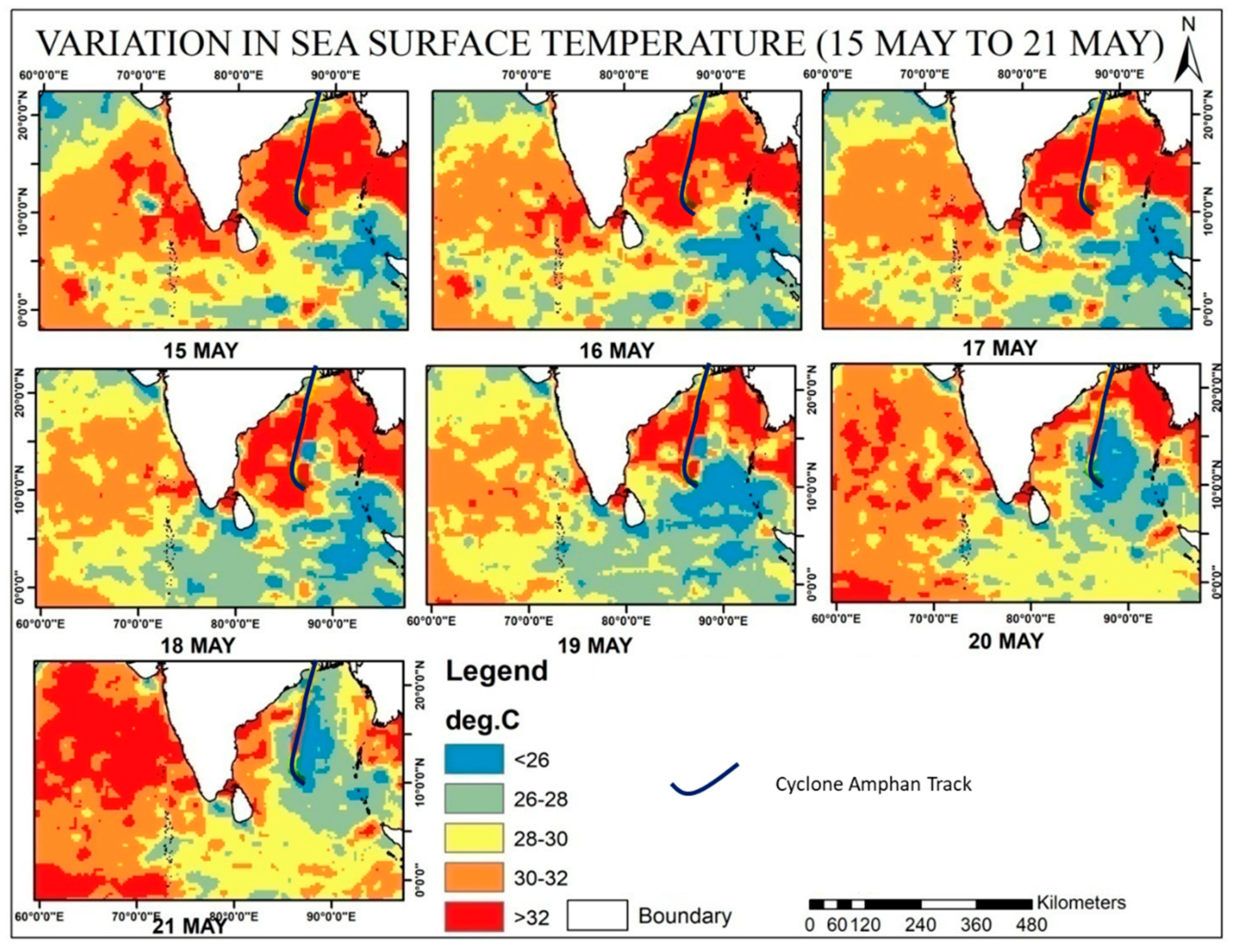

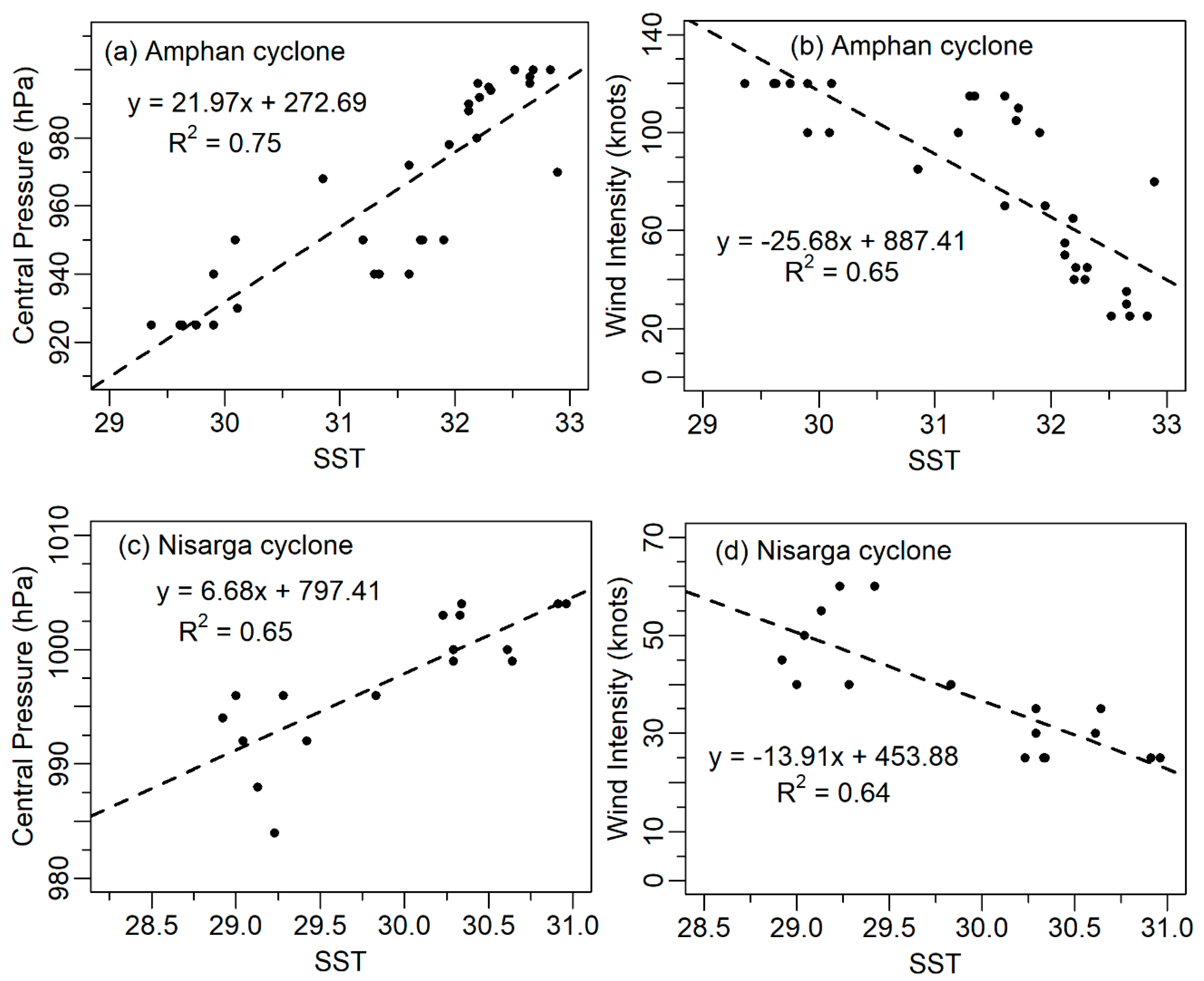
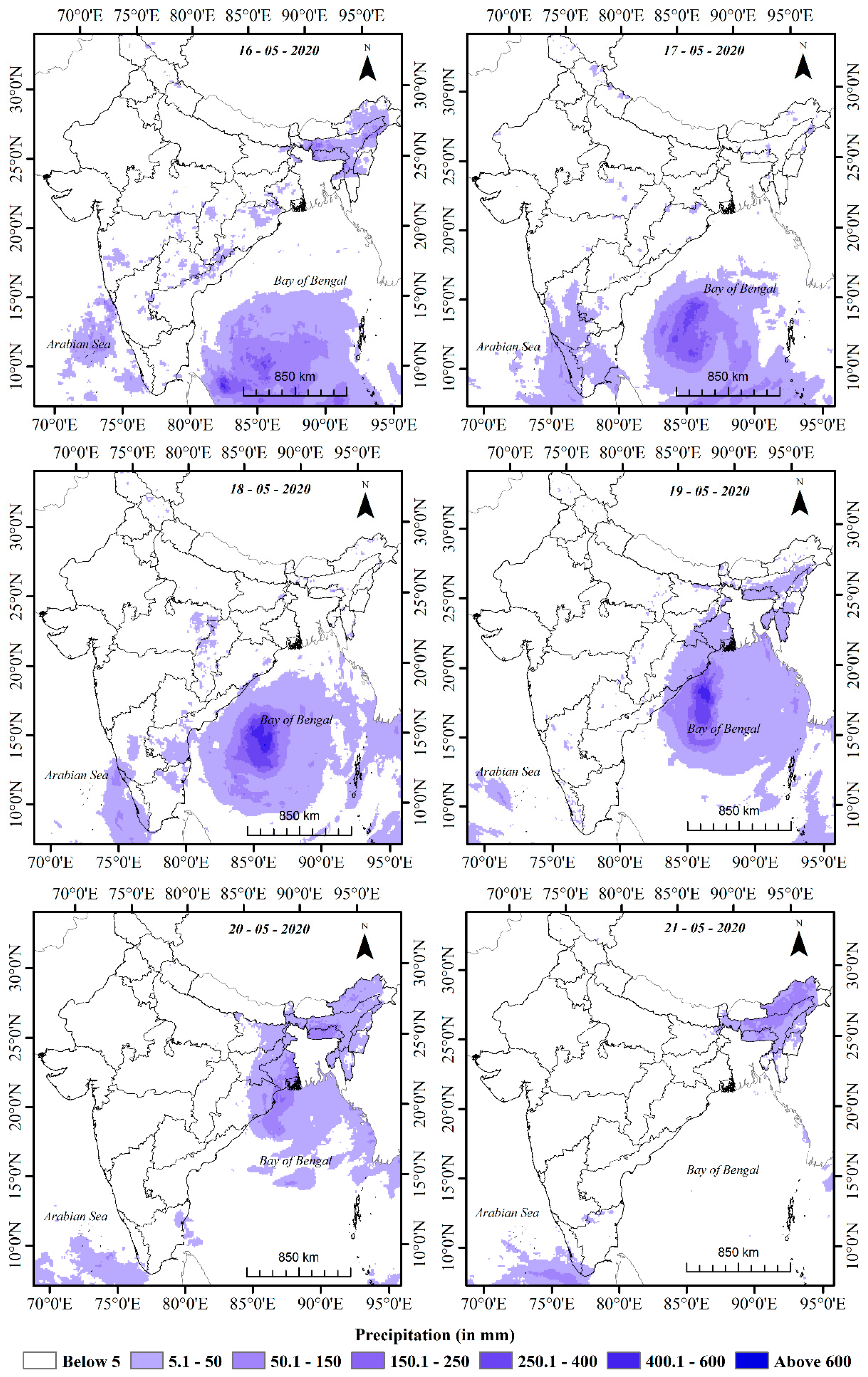
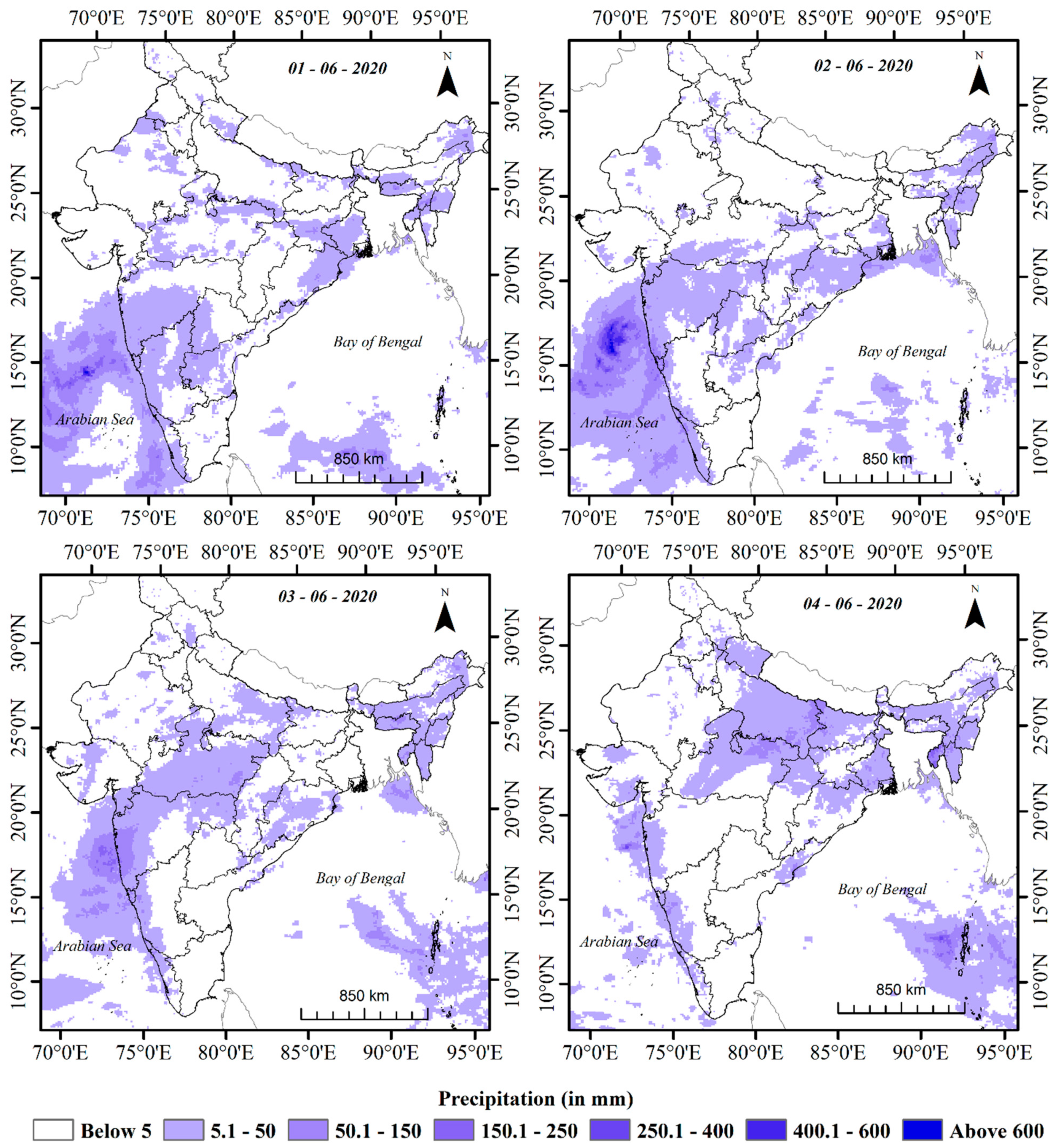
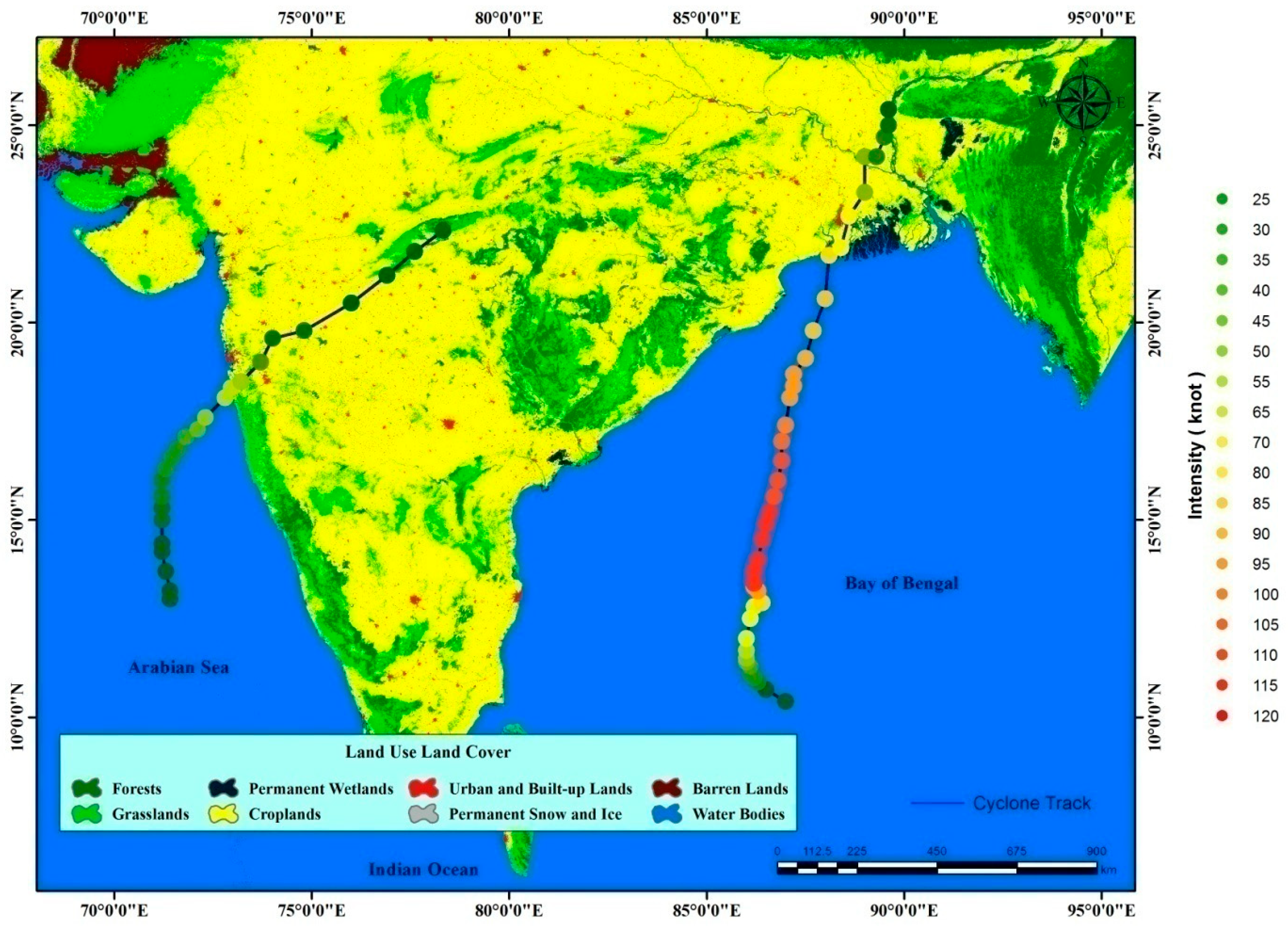
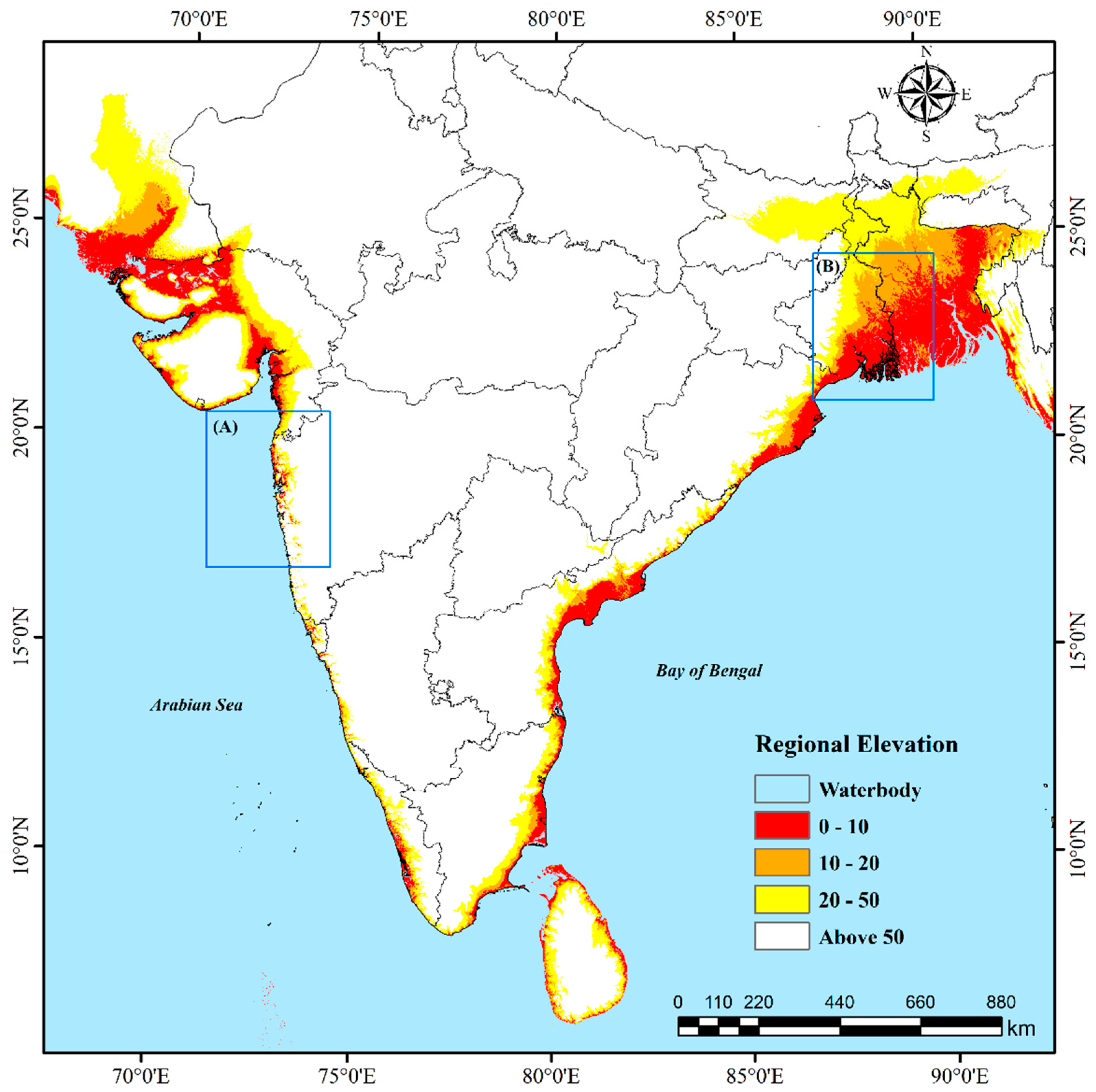

| Data Used | Spatial and Temporal Resolution | Purpose | Source |
|---|---|---|---|
| SCATSAT-1 (wind product) | 25 × 25 km; daily | wind speed and wind direction mapping | ISRO (https://www.mosdac.gov.in/) |
| NOAA OI SST | 0.25 × 0.25 degree; hourly | variation in SST during cyclones Amphan and Nisarga | NOAA (https://psl.noaa.gov/) |
| Global Precipitation Measurement (GPM) | 0.1 × 0.1 degree; hourly | precipitation mapping | NASA (https://gpm.nasa.gov/) |
| MCD12Q1 (MODIS) | 500 m; monthly | LULC mapping | USGS (https://lpdaac.usgs.gov/) |
| GEBCO | 1 arc sec | regional elevation | BODC (https://www.gebco.net/) |
| ALOS-2 PALSAR | 10 m | inundation mapping | Alaska Satellite Facility (https://asf.alaska.edu/) |
| Sentinel-1 | 10 m | inundation mapping | ESA (https://scihub.copernicus.eu/) |
| Amphan | |||||
|---|---|---|---|---|---|
| LULC Classes | Above 118 Knots | 117–75 Knots | 74–62 Knots | Below 61 Knots | Total Area (km2) |
| Forests | 0.43 | 65.38 | 25,990.65 | 11,232.76 | 37,289 |
| Grassland | 384.19 | 2433.57 | 27,071.41 | 22,579.6 | 52,469 |
| Wetland | 256.05 | 2985.52 | 7419.03 | 3723.55 | 14,384 |
| Cropland | 3461.14 | 43,109.22 | 130,423.1 | 56,397.57 | 233,391 |
| Urban | 19.2 | 1276.42 | 1499.06 | 990.61 | 3785 |
| Barren | 33.58 | 96.4 | 3907.58 | 6253.33 | 10,291 |
| Waterbody | 24.82 | 1206.57 | 5399.05 | 5597.58 | 12,228 |
| Total area (km2) | 4179.41 | 51,173.08 | 201,709.9 | 106,775 | 363,837 |
| Nisarga | |||||
| Forests | 0 | 504.27 | 558.32 | 1898.11 | 2961 |
| Grassland | 0 | 3683.94 | 5252.81 | 12,714.98 | 21,652 |
| Wetland | 0 | 141.71 | 105.57 | 61.6 | 309 |
| Cropland | 0 | 22,791.02 | 50,721.41 | 63,753.73 | 137,266 |
| Urban | 0 | 567.18 | 1505.97 | 888.2 | 2961 |
| Barren | 0 | 11.91 | 12.74 | 69.67 | 94 |
| Waterbody | 0 | 418.26 | 705.34 | 862.91 | 1987 |
| Total area (km2) | 0 | 28,118.29 | 58,862.16 | 80,249.2 | 167,230 |
Disclaimer/Publisher’s Note: The statements, opinions and data contained in all publications are solely those of the individual author(s) and contributor(s) and not of MDPI and/or the editor(s). MDPI and/or the editor(s) disclaim responsibility for any injury to people or property resulting from any ideas, methods, instructions or products referred to in the content. |
© 2023 by the authors. Licensee MDPI, Basel, Switzerland. This article is an open access article distributed under the terms and conditions of the Creative Commons Attribution (CC BY) license (https://creativecommons.org/licenses/by/4.0/).
Share and Cite
Basheer Ahammed, K.K.; Pandey, A.C.; Parida, B.R.; Wasim; Dwivedi, C.S. Impact Assessment of Tropical Cyclones Amphan and Nisarga in 2020 in the Northern Indian Ocean. Sustainability 2023, 15, 3992. https://doi.org/10.3390/su15053992
Basheer Ahammed KK, Pandey AC, Parida BR, Wasim, Dwivedi CS. Impact Assessment of Tropical Cyclones Amphan and Nisarga in 2020 in the Northern Indian Ocean. Sustainability. 2023; 15(5):3992. https://doi.org/10.3390/su15053992
Chicago/Turabian StyleBasheer Ahammed, K. K., Arvind Chandra Pandey, Bikash Ranjan Parida, Wasim, and Chandra Shekhar Dwivedi. 2023. "Impact Assessment of Tropical Cyclones Amphan and Nisarga in 2020 in the Northern Indian Ocean" Sustainability 15, no. 5: 3992. https://doi.org/10.3390/su15053992
APA StyleBasheer Ahammed, K. K., Pandey, A. C., Parida, B. R., Wasim, & Dwivedi, C. S. (2023). Impact Assessment of Tropical Cyclones Amphan and Nisarga in 2020 in the Northern Indian Ocean. Sustainability, 15(5), 3992. https://doi.org/10.3390/su15053992








